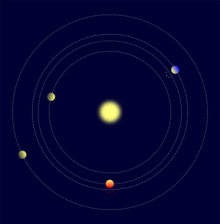开普勒223
| 观测资料 历元 J2000.0 | |
|---|---|
| 星座 | 天鹅座 |
| 星官 | |
| 赤经 | 19h 53m 16.40s[1] |
| 赤纬 | +47° 16′ 46.2″[1] |
| 视星等(V) | |
| 特性 | |
| 视星等 (g) | 15.903[1] |
| 视星等 (r) | 15.301[1] |
| 视星等 (i) | 15.105[1] |
| 视星等 (z) | 14.963[1] |
| 视星等 (D51) | 15.667[1] |
| 视星等 (J) | 14.095[1] |
| 视星等 (H) | 13.727[1] |
| 视星等 (K) | 13.632[1] |
| J−K 色指数 | 0.463[1] |
| 详细资料 | |
| 半径 | 1.095[1] R☉ |
| 表面重力 (log g) | 4.386[1] |
| 温度 | 5,599[1] K |
| 金属量 | -0.211[1] |
| 其他命名 | |
KOI-730
, 2MASS J195316.40+471646.1 | |
开普勒223(Kepler-223),旧称KOI-730(KIC #10227020),是一个位于天鹅座的恒星。开普勒空间望远镜已经在该恒星周围发现4颗系外行星[2]。
行星系统
[编辑]

开普勒空间望远镜已经在开普勒223周围检测到一个尚未证实的行星系统,包含四个行星候选者。天文学家最初认为其中两个行星处于共轨组态,围绕恒星旋转的轨道距离大约相同,公转周期为9.8天,它们位于60°的拉格朗日点,位置互相锁定[3] 。这两个共同轨道的行星被认为被其他两颗行星锁定在轨道共振状态,整体共振为6:4:4:3[4] 。这将是人类已知的第一个共同轨道的行星。
但是天文学家后续的研究表明,另一种可能性更符合观察到的数据,认为四个行星的轨道周期比例为8:6:4:3。此种情况不包含共同轨道的行星[5]。
fabrycky等天文学家认为这四颗行星的半径分别为地球半径的1.8、2.1、2.8和2.4倍,公转轨道周期分别为7.4、9.8、14.8和19.7天[6][7]。
参考资料
[编辑]- ^ 1.00 1.01 1.02 1.03 1.04 1.05 1.06 1.07 1.08 1.09 1.10 1.11 1.12 1.13 1.14 KIC10 Search. Multimission Archive at STScI. 8 October 2009 [5 March 2011]. (原始内容存档于2012-06-30).
- ^
Borucki, W.; et al.. Characteristics of planetary candidates observed by Kepler, II: Analysis of the first four months of data. The Astrophysical Journal. 2011, 736 (1): 19. Bibcode:2011ApJ...736...19B. arXiv:1102.0541
 . doi:10.1088/0004-637X/736/1/19.
. doi:10.1088/0004-637X/736/1/19.
- ^ Chown, Marcus. Two planets found sharing one orbit. New Scientist. Reed Business Information Ltd. [28 February 2011]. (原始内容存档于2012-10-22).
- ^ Emspak, Jesse. Kepler Finds Bizarre Systems. International Business Times. International Business Times Inc. [2 March 2011]. (原始内容存档于2012-04-20).
- ^ Beatty, Kelly. Kepler Finds Planets in Tight Dance. Sky and Telescope. 2011 [11 March 2011]. (原始内容存档于2012-05-29).
- ^ Dynamics of Cats, ExSSII: more transits (页面存档备份,存于互联网档案馆), Steinn Sigurðsson, 2011 September 12
- ^ Extrasolar Planets Encyclopaedia, KOI-730 (页面存档备份,存于互联网档案馆)
外部链接
[编辑]- New Scientist, "Two planets found sharing one orbit"(页面存档备份,存于互联网档案馆), Marcus Chown, 18:01 24 February 2011, Issue 2801
- "Planetary System KOI-730 Exhibiting a Pair of Co-Orbital Planets"(页面存档备份,存于互联网档案馆) (warning: this site requires a browser with support for "WebGL")
Text is available under the CC BY-SA 4.0 license; additional terms may apply.
Images, videos and audio are available under their respective licenses.
